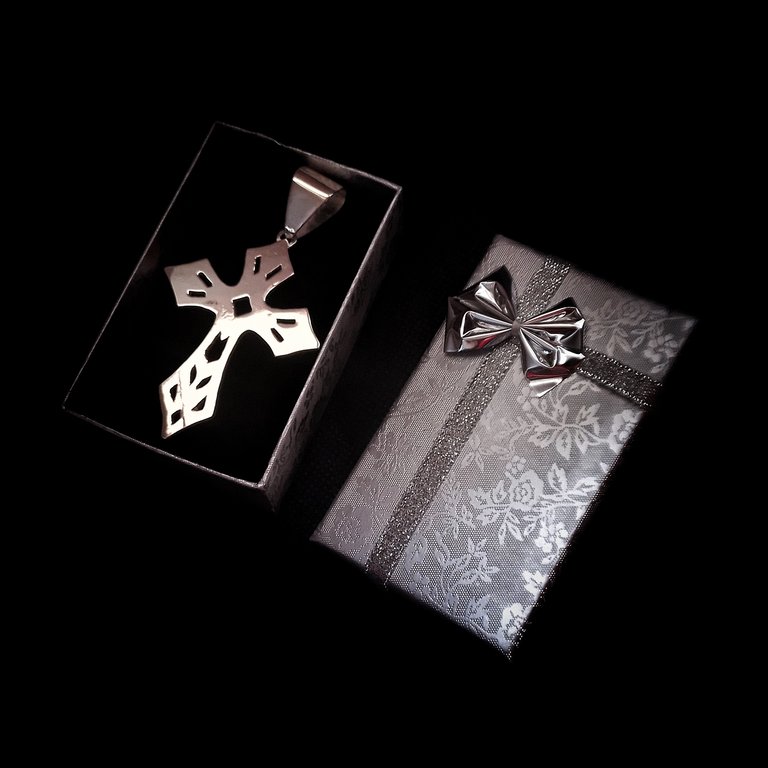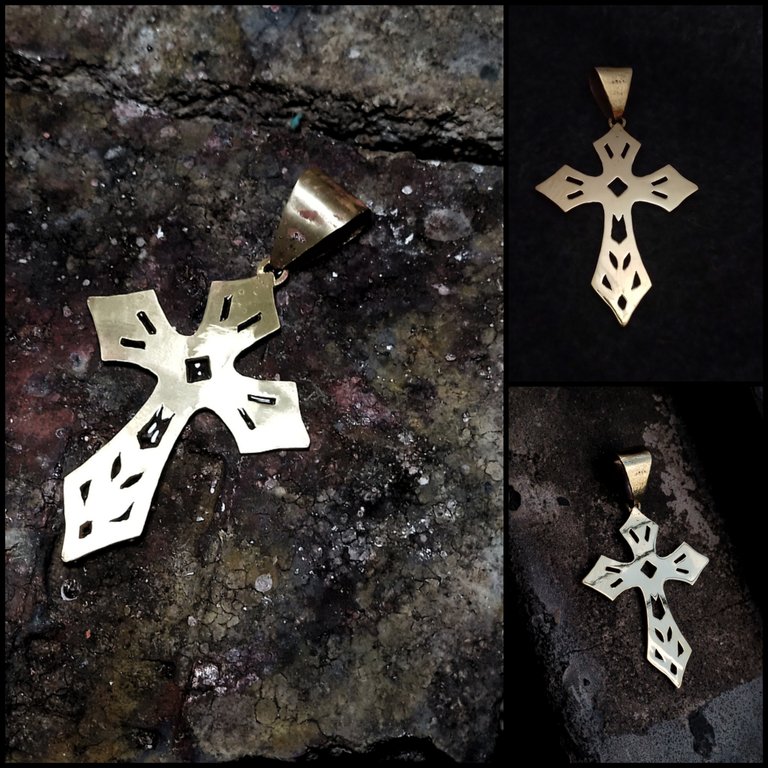
Hola amigos, de vuelta por aquí para enseñarles este proyecto de una cruz que fue un pedido que una joven quería regalar a su esposo. Dentro de las características que me dio, pidió que fuera para una cadena gruesa y que la cruz fuera lo suficientemente maciza para que pudiera resistir el uso diario, además de que la pieza era grande, aproximadamente 5 cm solo la cruz.
Las técnicas esenciales que usé para elaborar la cruz fueron el calado sobre metal y la soldadura. Las herramientas y materiales son los siguientes:
- Lámina de bronce de 1,2 mm aprox. y otro pedazo de 0,5 mm.
- Soplete, soldadura y bórax como fundente.
- Limas, lijas número 220, 360 y 400.
- Fresa para abrir hueco de 0,8 mm.
- Motor de pulir, disco de tela y cera de pulir.
- Dremel.
- Arco de segueta y sierras de joyería de 2/0.
- Pega Blanca.
- Pinza plana y redonda de joyería.

Imprimí el diseño y lo pegué en un pedazo de lámina con pega blanca. Previamente, pasé lija 220 para quitar la grasa y que pegara bien. Después, agarré el Dremel y la fresa para abrir huecos de 0,8 mm, con lo que abrí los agujeros internos por donde haría los cortes internos. Como la lámina era un poco larga, se me incomodaba trabajar con la segueta en las partes internas, por lo que empecé cortando la cruz por un lado. Después, hice los cortes internos, que es de la forma en que regularmente se trabaja.

erminé realizando el corte de la silueta con la segueta. Quité el papel de la impresión para revelar cómo me habían quedado los cortes. En verdad, un poquito irregular, pero bastante bien para ser una pieza gruesa que, para mí, no es tan sencilla; además, esos detalles se corrigen luego con la misma segueta y limando.
Ahora tocaba hacer la contra-argolla. Como no me era práctico ir a la PC a hacerla, sencillamente agarré un papel, lo doblé y fui cortando hasta alcanzar el tamaño apropiado. Luego lo pegué en una lámina de 0,5 mm y corté la silueta. Doble con un lápiz para ver cómo se ajustaba a nuestra cruz y sí, quedó bastante bien.

Durante esta fase que estaré explicando, iba corrigiendo con la segueta los detalles internos y con las limas partes de los detalles de la silueta. También fui limando y adaptando la contra-argolla para que pudiera entrar en el espacio que había determinado para ello. La modelé un poco mejor con las pinzas de joyería redonda y plana. Una vez ajustada, metí esta contra-argolla en el espacio del aro de la cruz. Luego, apliqué bórax y soldadura en el punto de unión de la contra-argolla. Después, fui lijando con las lijas en el siguiente orden: 220, 360 y 400, para, de esta forma, dejar la superficie de la pieza lista para pulir.
El proceso de pulido lo hice con el motor de banco y un disco de tela de algodón, al que le apliqué la cera. Con la fricción de este disco y la pieza, esta va agarrando un brillo tipo espejo. Limpié con agua y jabón desengrasante para quitar los restos de cera. Por último, seque y la pieza está lista.

Estas son las dimensiones de la cruz en comparación a mi mano.

Este es el resultado final de la pieza después de haberla mandado a bañar en plata y como la cliente la recibió. Para le entrega la metí en una cajita de regalo para joyería que tenía en casa y así ella pudiera regalar este dije de la mejor manera. La entrega se la hice personal y a ella el encanto el resultado y espero que a ustedes también...

Si quieren conocer las piezas que hago pueden visitar mi perfil:
https://Instagram.com/m16ueljoyas
Nota: Fotos tomadas con mi telefono Samsumg A03, edición de fotos Snapseed y PicsArt para los collages.
++++++
English / Mate Translate

Hello friends, back here to show you this cross project that was a request that a young woman wanted to give to her husband. Among the characteristics he gave me, he asked that it be for a thick chain and that the cross be solid enough so that it could withstand daily use, in addition to the fact that the piece was large, approximately 5 cm just the cross.
The essential techniques I used to make the cross were metal cutting and welding. The tools and materials are as follows:
- Bronze sheet of approx. 1.2 mm. and another piece of 0.5 mm.
- Torch, solder and borax as a flux.
- Files, sandpaper number 220, 360 and 400.
- Drill to open a 0.8 mm gap.
- Polishing motor, cloth disc and polishing wax.
- Dremel.
- Saw bow and 2/0 jewelry saws.
- White Paste.
- Flat and round clamp jeweler's.

I printed the design and glued it to a piece of foil with white glue. Previously, I used 220 sandpaper to remove the grease and make it stick well. Next, I grabbed the Dremel and the 0.8mm hole cutter, opening the internal holes where I would make the internal cuts. Since the sheet was a little long, it made me uncomfortable working with the saw on the internal parts, so I started by cutting the cross on one side. Afterwards, I made the internal cuts, which is the way we normally work.

I ended up cutting the silhouette with the saw. I removed the paper from the print to reveal how the cuts had turned out. In truth, a little irregular, but quite good for a thick piece that, for me, is not that simple; Furthermore, those Details are then corrected with the same saw and filing.
Now it was time to make the counter-ring. Since it was not practical for me to go to the PC to do it, I simply grabbed a piece of paper, folded it and cut until I reached the appropriate size. I then glued it onto a 0.5mm sheet and cut out the silhouette. I folded it with a pencil to see how it fit our cross and yes, it turned out pretty good.

During this phase that I will be explaining, I was correcting the internal details with the saw and with the files parts of the details of the silhouette. I was also filing and adapting the counter-ring so that it could fit into the space that I had determined for it. I shaped it a little better with the flat round jewelry tweezers. Once adjusted, I inserted this counter-ring into the space of the cross ring. Next, I applied borax and solder to the attachment point of the counter-ring. Afterwards, I was sanding with the sandpaper in the following order: 220, 360 and 400, in order to leave the surface of the piece ready for polishing.
I did the polishing process with the bench motor and a cotton cloth disc, to which I applied the wax. With the friction of this disc and the piece, it acquires a mirror-like shine. I cleaned with water and degreasing soap to remove any wax residue. Finally, dry and the piece is ready.

These are the dimensions of the cross compared to my hand.

This is the final result of the piece after having it plated in silver and how the client received it. To deliver it to her, I put it in a jewelry gift box that I had at home so she could give this pendant in the best way. I made the delivery personal and to her The result is charming and I hope you like it too...

If you want to know the pieces I make you can visit my profile:
https://Instagram.com/m16ueljoyas
Note: Photos taken with my Samsumg A03 phone, Snapseed photo editing and PicsArt for collages.
++++++
Saludos.
Está muy bello el diseño!
Tienes un don extraordinario.
Felicidades!
Gracias amiga